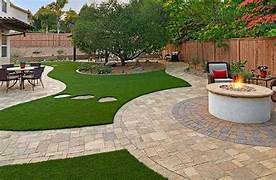Transforming your backyard with pavers and turf can create a beautiful and functional outdoor space. Whether you want a patio area, a pathway, or a low-maintenance lawn, this ultimate guide will walk you through the step-by-step process of installing pavers and turf in your backyard:
Plan and Design:
Start by envisioning how you want your backyard to look and function. Consider the size and shape of the area, the placement of pavers and turf, and any additional features like seating areas or planters. Create a detailed plan and sketch to guide your installation process.
Prepare the Area:
Clear the area of any existing vegetation, rocks, or debris. Use a shovel or a sod cutter to remove the existing grass or vegetation. Level the ground by removing any high spots and filling in low spots. Ensure that the area has proper drainage to avoid water pooling.
Excavation and Base Preparation:
Excavate the area to the desired depth for both the pavers and turf. Typically, a depth of 6-8 inches is suitable for the base. Use a shovel or a rented compact excavator to remove the soil. Compact the soil using a plate compactor or a hand tamper to create a solid base.
Install Edging:
Install edging material, such as plastic or metal landscape edging, around the perimeter of the area. This will create a clean separation between the pavers and the turf, preventing them from shifting and maintaining a neat appearance.
Lay the Base Material:
Spread a layer of crushed gravel or road base evenly over the excavated area. This layer should be approximately 4-6 inches thick. Use a rake or a shovel to distribute the material evenly and create a smooth surface. Compact the base material using a plate compactor to ensure stability.
Install Pavers:
Start by laying the pavers according to your design plan. Place the pavers one by one, ensuring they fit tightly together without any gaps. Use a rubber mallet or a hand tamper to ensure each paver is level and properly seated. Check the alignment regularly to maintain straight lines and consistent spacing.
Cut and Trim Pavers:
If necessary, use a wet saw or a paver splitter to cut and trim the pavers to fit along edges, corners, or irregular shapes. Measure carefully and make precise cuts for a clean and professional finish.
Add Joint Sand:
Once all the pavers are in place, sweep fine sand into the joints between the pavers. This sand will help stabilize the pavers and prevent them from shifting. Use a broom to sweep the sand evenly into the joints, and then use a plate compactor to gently vibrate the pavers and settle the sand.
Install Turf:
If you’re incorporating turf into your backyard, follow the manufacturer’s instructions for installation. Typically, it involves preparing the soil, laying a weed barrier fabric, and rolling out the turf over the prepared area. Trim the turf to fit the desired shape and use landscape staples to secure the edges.
Finishing Touches:
Once the pavers and turf are installed, assess the overall look of your backyard. Consider adding additional features like seating areas, outdoor lighting, or landscaping elements to enhance the space. Regularly maintain the turf by watering, mowing, and addressing any necessary repairs or replacements.
Remember, proper installation and maintenance are crucial for the longevity and aesthetics of your pavers and turf. Consult with professionals or refer to manufacturer guidelines for specific recommendations based on your unique backyard requirements. With proper planning and execution, you can create a stunning outdoor space that enhances the beauty and functionality of your backyard.

